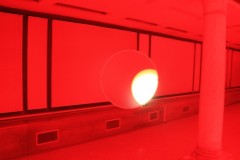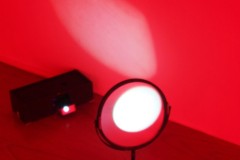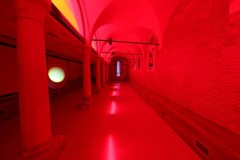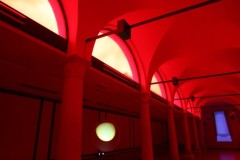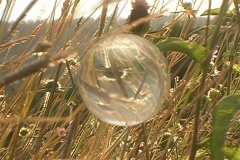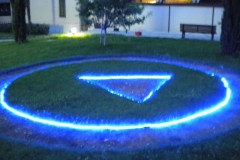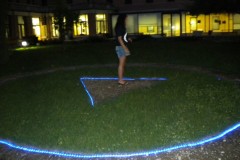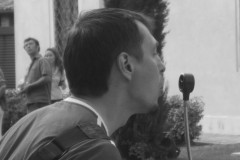Cyland Foundation Inc.
ARE PROUD TO PRESENT:
WE ARE HERE
an exhibition by Ludmila Belova, Alexandra Dementieva, Anna Frants, Ivan Govorkov, Elena Gubanova and Marina Koldobskaya
June 3rd—July 2nd, 2011 in parallel with the 54th Venice Biennale
Venice, Italy: Dorsoduro 1686
Waterbus stop: San Basilio
Curated by: Silvia Burini
Supported By: Cyland Media Art Lab; National Center for Contemporary Arts, St.Petersburg Branch; Cyland Foundation Inc; Fondazione Universita Ca Foscai.
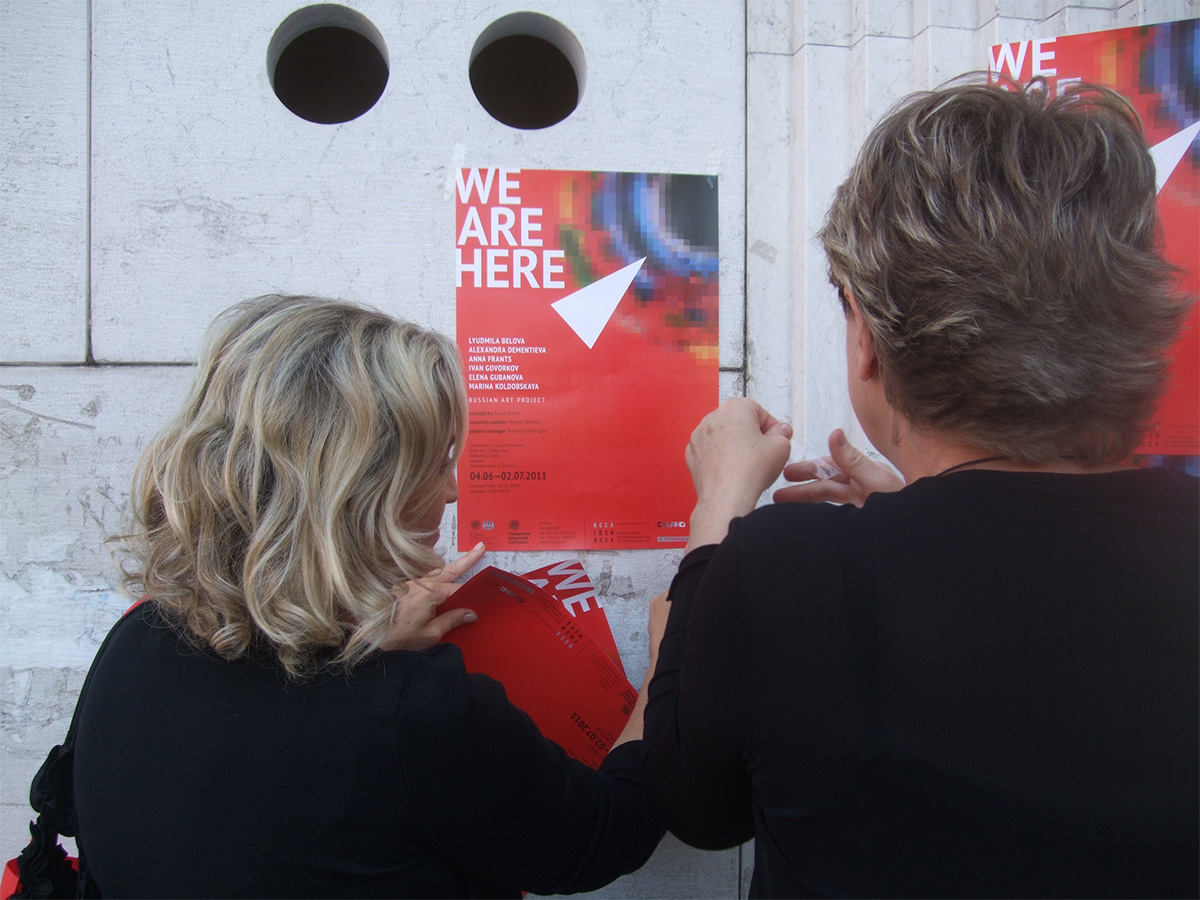
Artists and Works
Elena Gubanova and Ivan Govorkov – Redshift
Installation, 2011
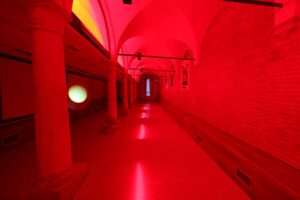 The artists use the astronomical term “redshift”. The astronomers can measure the space objects shift by the spectral lines position. In the project time is visualized with red color coming through the semicircular windows of the old Italian hall. The semicircular and crescent-shaped bright-red patches of light moving about the exhibition space are a symbolic image of the sun that the artists have generated within their own gigantic camera obscura.
The artists use the astronomical term “redshift”. The astronomers can measure the space objects shift by the spectral lines position. In the project time is visualized with red color coming through the semicircular windows of the old Italian hall. The semicircular and crescent-shaped bright-red patches of light moving about the exhibition space are a symbolic image of the sun that the artists have generated within their own gigantic camera obscura.
The Redshift project is dedicated to astronomy, a science that, among its other achievements, has made it possible to conceptualize the idea of time, to turn it from a speculative construct into a visual fact. The project deals with subjective time, which has its own wrinkles and is measured rather by the memory of the artists, one of whom grew up in the most utopian place on the Earth, the Pulkovo Astronomical Observatory, the principal observatory of the Russian Academy of Sciences, than by rotation of the astronomical bodies. This is a project dedicated to the memory of our expanding Universe, which transmits to us the decelerating light of the stars.
Alexandra Dementieva – Contact Field
Site-specific interactive installation, 2011
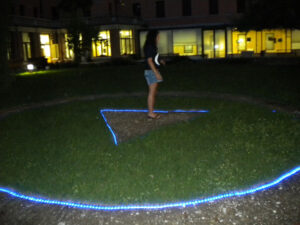 The principal feature of the Human Being is his desire to communicate, to create links, to exchange ideas, to discover. Since forever, people have been in constant movement. First they met nearby tribes, later established connections with other countries and continents. Bringing along their culture and tools and exchanging them with others, they enriched themselves and this process was expressed in technological and spiritual development. It has not always been this way, but I want to focus now on their endeavor for enlightenmentillumination. One of the sweetest dreams of mankind was to meet other intelligent life.
The principal feature of the Human Being is his desire to communicate, to create links, to exchange ideas, to discover. Since forever, people have been in constant movement. First they met nearby tribes, later established connections with other countries and continents. Bringing along their culture and tools and exchanging them with others, they enriched themselves and this process was expressed in technological and spiritual development. It has not always been this way, but I want to focus now on their endeavor for enlightenmentillumination. One of the sweetest dreams of mankind was to meet other intelligent life.
There are a lot of legends and myths devoted to this subject. Recently, scientists published their hypothesis that very soon they would have to discover a planet that will have very similar life conditions to ours. This installation is the “landing field” at the University of Venice.
To mark it, the author uses a sign – containing two shapes : circle and triangle – the pictogram ‘PLAY’ . The meaning of it is known to everyone and understandable for any intelligence: to start action. It is like an invitation for the aliens to land and open a new era together with humans. Its shape will be cut in lawn grass and can stay there throughout the summer. In the evening, when it becomes dark, the sign could be lit by the viewer breathing into the flow detector that will be installed on a podium right in front of the grass’ pictogram. For this purpose, the the LED lamp strip is used, it placed around the shape. It will be invisible during the daytime and begin functioning in the night.
Ludmila Belova – Home
Video, 2007
The film is inspired by the stories and diaries of the astronauts that have spent a long time on the orbital stations and have done spacewalk.
Observing Earth, you often think about it. You often recall your own life on the Earth, smells of grass and forest, birds singing. Man in space keenly feels the lack of earthly connections and often recalls them. A good book is needed in space that would narrate about life on the Earth, about people, their relationships, about Earth nature. In rare free moments one wants to read earthly books and see earthly pictures. On the board of our “Soyuz-9”we had several color photos of the Baikal picturesque scenery. I recall with what delight we were looking through them on the 10th day of our space mission.
Extract from the diary of Vitaly Sevastianov, a space pilot
Anna Frants and Marina Koldobskaya – We are Here
Sound installation, 2010
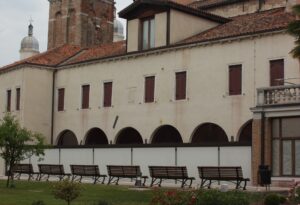 The viewer is going through a long semi-dark corridor and suddenly right nearby somebody’s breathing, heavy and powerful. It’s the breathing of an invisible giant. Somewhat farther along, there are sighs of a sleeping child, easy and peaceful. Still farther, some old and, apparently, sick person is wheezing. The exiting viewer is accompanied by a deep sigh of relief. These sounds act as a reminder: We are here, we are always here, we are right next to you. Who are they, the invisible ones? Genii loci? Prisoners of an old fortress? Bogeymen, wood goblins, poltergeists? Inhabitants of our memory? An elementary audio recording awakens ancient animism in the soul of a modern person – everybody is alive; everything is alive.
The viewer is going through a long semi-dark corridor and suddenly right nearby somebody’s breathing, heavy and powerful. It’s the breathing of an invisible giant. Somewhat farther along, there are sighs of a sleeping child, easy and peaceful. Still farther, some old and, apparently, sick person is wheezing. The exiting viewer is accompanied by a deep sigh of relief. These sounds act as a reminder: We are here, we are always here, we are right next to you. Who are they, the invisible ones? Genii loci? Prisoners of an old fortress? Bogeymen, wood goblins, poltergeists? Inhabitants of our memory? An elementary audio recording awakens ancient animism in the soul of a modern person – everybody is alive; everything is alive.
“God Possibly Surrounds” – said the poet Alexander Vvedensky. It was in Leningrad in 1930. A completely different age, a different country, a different city – everything was different and had a different name. But these words have remained because no more important words could be said.
History, one way or around, “surrounds” – the everyday career and domestic fighting against a background of the global news: vibrations of the political regimes, fluctuations of the social climate, economic booms and crises, marvels of science and fancies of art.
The poet said: “Possibly”. If there is enough levity, we assume that all that is happening has a meaning. If there is enough courage, we do not assume. “The star of non-sense shines, It alone is bottomless” – that’s what he said.
“God” is the one who called you, and, whether you like it or not, you will have to reply: “This is I”.
So, if He – Possibly – Surrounds, then where – in reality – are we?
We are here.
This is a project about presence.
Sooner or later, the light of distant stars reaches us. In an electronic telescope, red stars look exactly like rag rugs crocheted by our grandmas. On school photographs, little red stars are fastened to school uniforms. Familiar faces emerge on a film in the red light of a darkroom. Red light from the church stained-glass windows bathes the figures of parishioners.
Our memory is the only thing that connects these things. Even though these things have no connection to us. The distant stars had been gone long before we were born. People on the photographs no longer exist. Masters that were building the church did not know that we would come there. It is not for us that the parishioners are praying. But rags gather into rugs, rays into a star, shadows on a glass into faces – if we think about them and while we think about them.
We think about those who were here. About the people who lay these walls. About the people who lay them anew. Who were present when everything had a different name, in a different country, in a different city. Those people are here; they are breathing in our faces. The rhythm of this breathing matches ours. They are everywhere. Maybe they are not even people.
We think about those whom we do not know. About the Others. It is hard for us to overcome the fear that somebody is watching us. It is hard for us to abandon the hope that somebody is actually bothered with us.
Whatever they may be – angels, ancestors, intelligent microbes or extraterrestrials – we always expect guests. We prepare for the encounter. They will come and, together, we shall push PLAY.
We shall play a new game whose rules are unknown to us. In fact, there are no rules, what rules could there possibly be when He surrounds. We are leaving for outer space without leaving our home. Water drops fly by like planets, and each of them reflects a world. The Book soars in the sky; grass grows sky-high and, in it, we are no bigger than a grasshopper.
But we are here. We are always here.
Marina Koldobskaya
Related links:
Università Ca’ Foscari Venezia

